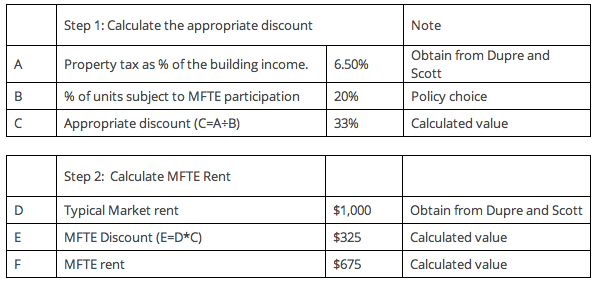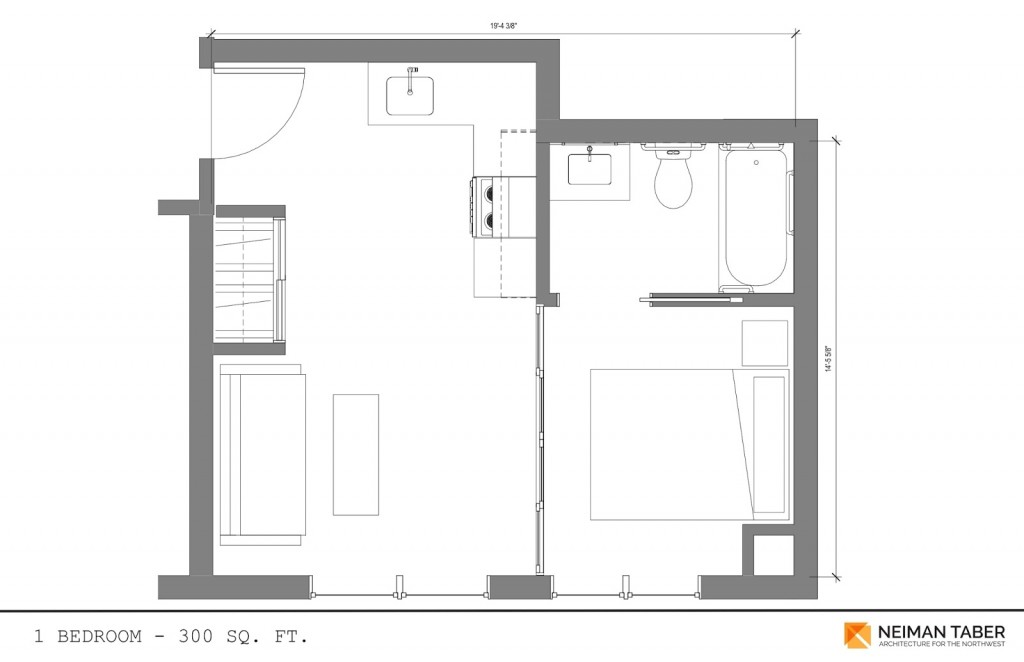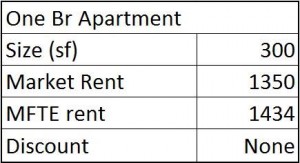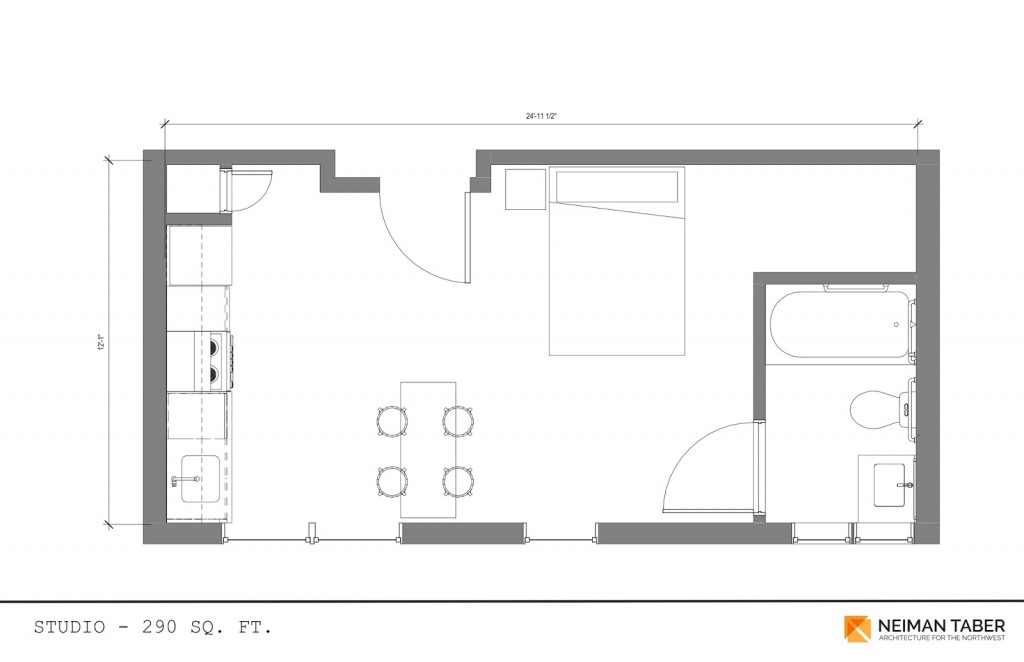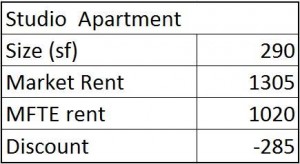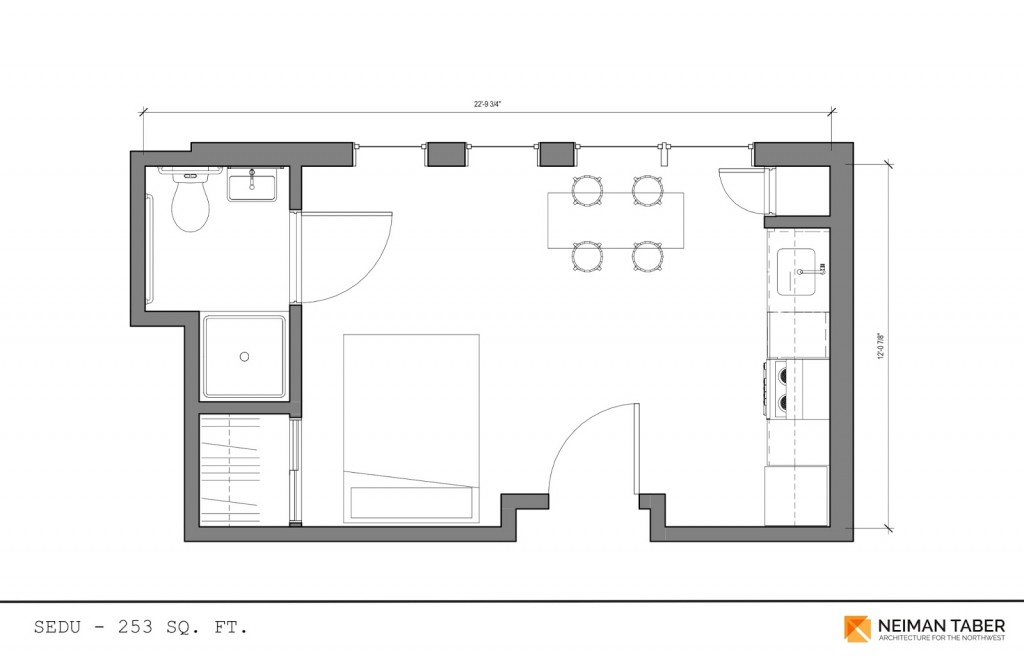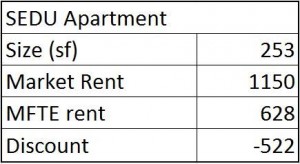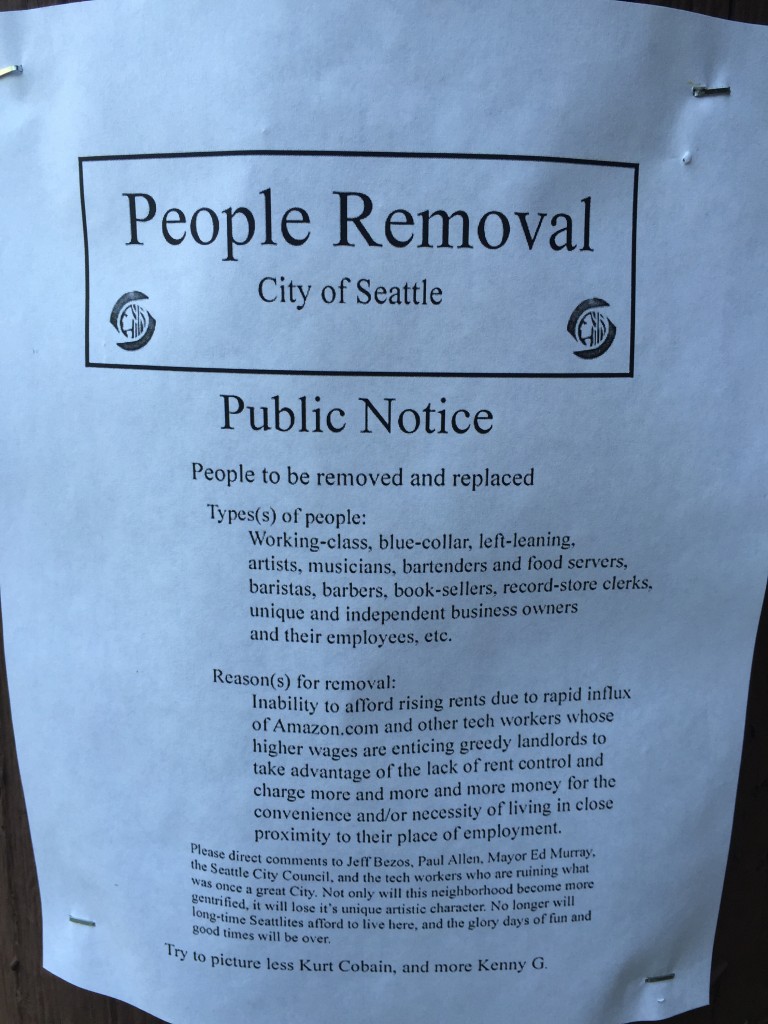Tower Separation Anxiety
Councilmember Sally Bagshaw last week sent a letter to Mayor Murray asking him to direct the Department of Planning and Development to undertake a tower spacing scheme for downtown similar to the program implemented in South Lake Union. What tower spacing does is mandate allowing only one residential tower per block. This is a recipe for reduced housing options downtown by limiting the potential of housing throughout downtown. Suddenly buildable property that could have been housing ends up staying a parking lot. This means reduced housing options for people with more money to spend for housing, money they’ll spend competing against people with less money for scarce housing.
Here’s a key paragraph from the letter.
Downtown has since experienced greater than anticipated growth in residential uses in both DOC1 and DOC2 zoned areas. This pattern of increased residential use in our urban core merits further study by planners to determine how to support growth while simultaneously preserving livability for workers and residents.
Livability here really is code for views, especially views from the million dollar condos at the Escala (one is being offered now for $1.8 million). This whole letter writing excercise has me worried because it reminds me too much of a similar letter written by Councilmember Sally Clark at the end of 2013 to “fix” problems in the low-rise zones. That letter sparked one of the most disastrous episodes in Seattle land use memory: the DPD’s proposed “fixes” to the low-rise zones which didn’t fix anything unless you were an angry neighbor upset about seeing “too many buildings and not enough sky!”
For her part, Councilmember Bagshaw has been resentful of my challenges to her efforts here on behalf of her well heeled constituents in an election year.
Your tone is becoming significantly more strident and less helpful. Your assumptions are just that. Assumptions. I am happy to work directly with Matt and Peter, and by this email will encourage them to continue this conversation with me to address the concerns raised by downtown residents and builders.
By assumptions, Councilmember Bagshaw is referring to my pointing out that it really isn’t fair that some rich neighbors worried about views and being able to see the sky is the basis for those people to get special treatment from Council and DPD staff, especially when we’re going to lose housing supply because of it. And she’s talking about Matt Roewe a brilliant architect who has been a long time champion of density and Peter Steinbrueck former City Councilmember and land use chair. Here’s what sparked her response. I wrote:
But we don’t need this now. And regardless of your motivations, there is no doubt that this is being pushed largely by residents of those buildings that will lose views. Peter Steinbrueck was employed by the Mirabella for the same reasons. Peter, have you been hired by any of these resident groups? That’s not bad, just asking.
The HALA proposals are still settling in as is the Grand Bargain. It makes no sense to me to begin traveling down this road now. Please let the HALA process move and let this follow.
Furthermore, I place less value in the views, light, and air of existing residents than I do in the many people who want to live here. We’re in a housing crisis remember? Why would we privilege some comparatively trivial things to housing?
Strident? I’ll let you and the dictionary be the judge of that. And is former Councilmember Steinbrueck, the “expert” that Councilmember Bagshaw is relying upon to propose tower spacing in the employ of wealthy Escala residents? Yes, he is.
Yes I represent a growing collation of downtown residents who love highrise living and the urban environment, but are unhappy with the seriously flawed development standards that allow overcrowding in parts of downtown.
And who lead the Council process to develop those development standards that Steinbrueck now characterizes as “flawed?” I hope this doesn’t sound strident but, well, it was Peter Steinbrueck. Yeah, that’s right. Do a tour on the Seattle City Council, goof up the code, then come back as a hired consultant for a sitting Councilmember pandering to wealthy, entitled neighbors to “fix” your mistakes. I can’t wait for Councilmember Clark to come back as a consultant to “fix” what she started in the low-rise zones.
Oh and is having fundraisers in the Escala, hiring a former Councilmember as an “expert” in the employ of Escala kosher with Wayne Barnett at Seattle Ethics and Elections? Sure!
Yes, Roger, it is. The ethics code expressly excludes campaign contributions from the section covering gifts.
This is the Seattle City Council that is supposed to preside over solving the housing “crisis” and implement the Grand Bargain with rezones all over the city. I think you’ll see why I might sound, well, a little strident.
David Neiman: A Smart and Fair Approach to MFTE
The MFTE program is a vitally important tool that leverages market rate development participation in the effort to increase the supply of affordable housing units in Seattle. Over the last couple years, the city has struggled to incorporate small unit development into the program. City policy has been at turns overly permissive and punitive, with the result that the current legislation effectively prohibits participation by small unit development. Given the inherent ability of small units to reach deeper levels of affordability, we must change the MFTE program to incorporate SEDU and congregate housing while ensuring fair public benefit is returned.
Currently Neiman Taber is working on three congregate housing projects with a total of over 200 units of housing. Each of these projects wants to participate in the MFTE program, but under current rules this is not possible. Below are our suggestions for improving the MFTE program:
1) Create and publish an explicit rubric for how the MFTE rent is calculated.
The calculation is not difficult, and relies on only a few variables, all of which are readily available through public records and published data sets. The variables are:
- Value of the property tax relief as a percentage of the building rental income. This number is available through Dupre & Scott as part of their standard reporting.
- Percentage of units that you want to discount. Policymakers get to choose the number, for example 20% or 25%.
- Typical market rent for new construction. Again, this number is available through Dupre & Scott.
Once the proper data is collected, calculating the appropriate discount is quite simple:
In the above example, all of the data needed can be obtained from market surveys that are widely available and easily verified. The math is explicit, clear, and unassailable in terms of representing a fair value for value exchange. Publishing a rubric like this would both explain to the public how the program works and provide a clear way forward for future council members to steward the program in a way that is objective, responsible, and fair.
2) Use the official rubric to calculate an appropriate MFTE rent for a given type of unit.
The recent adjustment of MFTE rents for SEDUs is an example where the appropriate rent and percentage of units required to participate does not stand up to an objective study of market rents and the value of the property tax relief. The current MFTE proposal from the Mayor’s office for congregate units appears to be closer to the mark, but the rents proposed for SEDU’s remain strangely disconnected from reality. Based on the current system of classifying units by type and bedroom count, the following values are roughly in line with market rents, using either 20% or 25% participation.
3) Change the way unit types are classified to remove incentives to game the system.
The current system of classifying units by the number of bedrooms creates an incentive to provide the smallest possible unit within a given category in order to give the least possible discount in exchange for MFTE participation. This formula encourages developers to game the system, creates odd unit designs, and diminishes the value returned to the public. The example below shows three units from one of our current projects. These units are not significantly different from one another, but due to the coarse steps inherent in the current classification system, they behave very differently under the MFTE program.
Another factor to be considered is that as units get smaller, relatively minor differences in the size of units have a big effect on price as a percentage of the rent. A review of market data for micro-housing shows that the variation in size between a small congregate unit and a large congregate unit is over 50%. Treating all size units the same has the effect that the projects with larger and more livable units are the least likely to participate, while the projects with smallest units are the most likely.
These perverse incentives can be solved by using a simple table similar to the ones that every American uses to calculate their income tax. The table has a few gradations of unit size and rent per square foot. Each value would be created using market data. Calculation of the appropriate market rent for a given unit and the corresponding MFTE rent is a simple process, as illustrated below:

4) The MFTE is a voluntary program. The family size unit “incentive” will not work.
One of the defining features of the MFTE program is that participation is voluntary. Because of this feature, a fair value for value exchange must be offered in order to encourage participation. If policy makers ask for more in rent concessions than is warranted by the value of the property tax exemption, developers simply choose not to participate. Attempts to “extract” more value from developers than the tax exemption is worth makes for a great applause line, but doesn’t actually work in practice. To the contrary, it simply drives potential participants away from the program, resulting in fewer affordable units.
The recent proposal to incentivize family size units by mandating a higher percentage of affordable units unless developers provide at least 4 two bedroom units in their projects is an example of a misguided extraction attempt. The result of this policy will be:
- Larger projects, where provision of a few larger units is customary, will get a benefit in exchange for doing nothing more than what they were planning to do in the first place.
- Smaller projects where provision of a few large units is difficult will find that MFTE is bad deal & simply will not participate.
The section intended to encourage two-bedroom units should be removed from the legislation. Family sized housing is an important issue, but cannot be effectively incentivized using a voluntary program like the MFTE. Attempting to do so is counter-productive and makes it harder to responsibly administer and steward the MFTE program in a way that maximizes participation and public benefit.
Thanks to MFTE and the Levy, Affordable Housing is All Over Seattle
Joshua McNichols at KUOW has done us all a great favor, creating a high quality interactive map of subsidized affordable housing in Seattle. Two things matter here. First, you can see that the housing units are all over the city. As I pointed out before, this flies in the face of the argument that somehow subsidized affordable housing is not where people work or close to transit. And the idea that there is segregation with the subsidized units only in a small part of the city is simply false. The second point is why: the Seattle Housing Levy and the Multifamily Tax Exemption (MFTE) Program. These two programs do everything that inflationary inclusion, incentive, and linkage schemes claim to do, but really actually create lots of subsidized units without penalty to new housing.
This map should change the whole discourse on housing, shifting it away from efforts to penalize new housing to build subsidized affordable housing. Through a fair and widely shared property tax, the Levy creates thousands of units for people earning between 0 and 60 percent of Area Median Income (AMI), and the MFTE creates thousands of units for people earning between 60 to 80. Why not just improve these highly productive programs to meet Seattle’s housing need? Someone has to pay a penalty for making housing. It’s a terrible way of doing things, but that’s exactly what the Grand Bargain is, a scheme that essentially taxes and fees new housing to create subsidized units. We don’t need to punish people building new housing, we just need new housing and the Levy and the MFTE do that, all over the city, without adding any cost to new housing.
Housing Debate: We Lack an Intellectual Foundation
The housing discussion in Seattle lacks a solid intellectual footing in economic principles. When people debate housing here, there is rarely a clear starting point when people take positions or make “bargains.” I would suggest that those who build housing need a set of simple, clear principles to judge whether something is a bargain or not for us and for our customers. And when Council asks us to give up housing capacity somewhere, that we demand that they replace that capacity somewhere else.
At last weeks hearing on the proposals contained in the report of the Mayor’s Housing Affordability and Livability Agenda (HALA) Committee and here on the blog, I voices skepticism about the so called “Grand Bargain” between developers and others to accept inclusionary zoning to avoid linkage taxes. In the post on The Stranger’s blog, a commenter summarized my points perfectly:
1. The HALA report falsely assumes that growth is an impact, when actually it is quite beneficial.
2. Some developers (“some of my guys”) will find that the incentive of being allowed to add an extra floor in exchange for providing 10% affordable units just won’t pencil.
3. Inclusionary housing is an inherently inflationary policy.
The first and last point is a perfect example of how we’re adrift. I realize that the political reality at the negotiating table was “developers have to give up something” to avoid linkage taxes, a per square foot tax on all new development which was proposed by Councilmember O’Brien. But new housing is not a bad thing that needs some kind of offset and adding costs to new housing won’t make it cheaper. Making that point isn’t breaking away from any coalition or coming out against the Grand Bargain, it’s simply holding the whole process accountable to our own bedrock economic principles.
Our intellectual operating system should be programmed to always start up with these points:
- If it is argued that housing prices are too high we need to ask, “by what measure?”
- If prices are high by an acceptable metric, then we know that scarcity is the reason and therefore we need more housing.
- That new housing will sell or rent for more than older existing housing.
- That’s ok, because that means newer housing can absorb demand from people with more money to spend and they won’t compete with existing tenants of older housing or new arrivals to the city with less money.
- That new housing, built at private risk and expense, is a public benefit to the whole community.
- Anything, even things that are vital and necessary like health and safety requirements, that add costs and limit capacity always increases the price.
- So any regulations or added costs should more than offset the loss of housing and that lost capacity should be replaced.
- Any value capture scheme to take advantage of increasing or improving housing shouldn’t add time or costs to the production of new housing
- Numerical targets for housing are by their nature arbitrary and should be revisited in favor of careful tracking of how the market is responding to demand
- At whatever point the market fails to meet demand, interventions to support people too poor to pay rents to support the cost of land, construction, financing, and operations should be broad based and expect contributions from those most inefficiently using limited land in the city (i.e. Single-family homeowners)
Let me say that had the negotiators been armed with these principles (which each have strong data and deep, well argued intellectual roots to support them) and had they held themselves accountable to them, we almost certainly see Councilmemeber OBrien’s disastrous linkage scheme forced fed to us. Why? The view that housing scarcity is the source point of higher prices is still a novel one both intellectually and politically. Politicians and voters still think, along with other wrong ideas, that building more new housing makes all housing more expensive.
Yes, I’m saying that even if we had principles and stuck to them, some inflationary scheme would have been imposed on us. But having principles is starting to work. When I spoke over the last week at different times with a reporter and a candidate for the City Council each expressed the following in a very matter of fact tone: “If we don’t get more expensive, newer housing then those people who can afford those prices will bid up cheaper, older housing.” This reality is now becoming conventional wisdom among the press and the political class partially because we’ve argued for it over, and over, and over, and over again in comment threads and blog posts for years!
We’re winning! Or at least there is hope. And when we do lose, we must be able to understand that we did, indeed, lose and exactly why. Ronald Reagan as Governor campaigned against a withholding tax saying his feet were in concrete on the issue. But when subsequently signed the tax into law after losing a political battle, he said “I can hear the concrete cracking around my feet.”
Intellectual concrete around our feet isn’t just optional it’s essential if we are going to get to a cultural norm in Seattle that supports all new housing as a public benefit. Even when that concrete breaks there is something left to repair and build up again. People are starting to get it. Let’s not stop now.
Latest Pole: Some People Hate Growth
Here’s the latest in telephone poll poster politics. This narrative about growth and development is held by a great many people in Seattle. It’s a fantastical story about how people who get good jobs are to blame for all of Seattle’s troubles. See, a person gets job, a greedy landlord knows that, raises rents when that person buys housing, and prices go up for everyone.
Simple logic would tell you this isn’t true. But economics is even clearer. When we don’t keep up with demand for housing, and there are people looking for housing, people who earn more will win a bidding war for scarce housing. Clamping down on housing supply in the face of rising demand is a recipe for poor people suffering.
But for some, growth is just a big bad wolf and we’re Little Red Riding Hood. Fairy tales make easier reading than economic text books.


